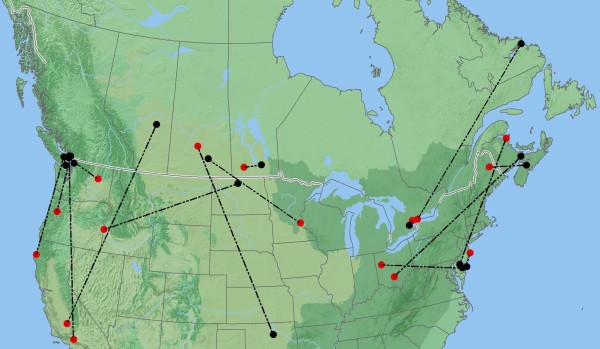|
RESEARCH |
||||
MRF has requested and received from the Bird Banding Office a copy of the list of all Short-eared Owl banding recoveries in North America as of November 2006. We are grateful to the many banders who contributed to this data set over the past century. We will prepare a more detailed summary of the file, but can provide here a few simple statistics from our preliminary analysis. A total of only 50 recoveries have been reported, ranging in date from 1923 to 1997. Of these, 29 were banded in Canada (17 British Columbia, 4 Alberta, 1 Saskatchewan, 1 Manitoba, 2 Ontario, 2 Nova Scotia, 2 Newfoundland and Labrador), and 21 in the United States (1 Hawaii, 2 Washington, 1 Oregon, 1 Utah, 1 Idaho, 1 North Dakota, 2 Wisconsin, 1 Kansas, 1 Oklahoma, 3 New York, 1 New Jersey, 3 Delaware, 3 Massachusetts). Nearly two-thirds (66%) of individuals were recovered in the same state/province as banded, and 30% were in fact banded and recovered within the same 10-minute block. Some individuals, however, did cover substantial distances, with 8 individuals recovered more than 1000 km from where they were banded (see map below). The longest span between banding and recovery was 4 years, 2 months. The vast majority (84%) of recoveries were of dead birds. Of the 18 mortalities for which a cause of death was known or presumed, the most common were aircraft collisions (3), highway deaths (6), and shooting (7). Eleven of the birds were banded as nestlings or recently fledged juveniles, 8 others as hatch-year birds, and 24 as after-hatch-year birds, with the age of the remainder unknown. Sex was reported as unknown for all but one male and one female, suggesting that future banders should make it a priority to attempt to determine sex if at all possible, either through a combination of measurements and plumage characteristics, or by collecting a feather sample for testing (only if in possession of a valid permit for that purpose). Photographing any birds banded to develop a visual reference library of known age/sex Short-eared Owls would also be valuable.
|

